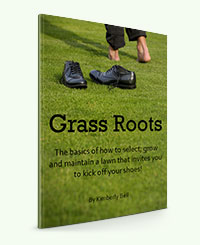Grass Roots Ebook
Table of Contents
Introduction
Selecting the Right Grass:
Choosing the Right Cool Season GrassChoosing the Right Warm Season Grass
Seeding and Establishing Your Lawn:
New LawnRenovating an Existing Lawn
Maintenance and Care for Lawns:
MowingIrrigation
Dethatching
Fertilizing
Aeration
Weed Control
Disease
Sustainable Lawns
Organic Lawn Care
Improve Your Soil the LazyMan™ Way!
Introduction
 There are many who adamantly oppose the heavy use of turf grass lawns due to a variety of environmental reasons, and there are justifiable reasons to not grow grass in such huge expanses. Balance and moderation even have a place in the area of turf, and creating a varied and diverse landscape is wise and beneficial. However, there are certainly environmental benefits of having areas of turf grass, such as the ability of grass to stabilize soil against water and wind erosion, as well as providing one of the most effective groundcovers to increase water infiltration into the soil. During hot temperatures, turf grass has a cooling effect on the environment, and grass also improves air quality, lessens noise levels and reduces light reflection and glare. There are arguments that healthy, sustainable lawns do have their place in our environment.
There are many who adamantly oppose the heavy use of turf grass lawns due to a variety of environmental reasons, and there are justifiable reasons to not grow grass in such huge expanses. Balance and moderation even have a place in the area of turf, and creating a varied and diverse landscape is wise and beneficial. However, there are certainly environmental benefits of having areas of turf grass, such as the ability of grass to stabilize soil against water and wind erosion, as well as providing one of the most effective groundcovers to increase water infiltration into the soil. During hot temperatures, turf grass has a cooling effect on the environment, and grass also improves air quality, lessens noise levels and reduces light reflection and glare. There are arguments that healthy, sustainable lawns do have their place in our environment.Landscape plantings, including lawns, around homes and businesses has a proven, positive effect on people. A healthy, uniform lawn provides a flow and harmony in the entire landscape scene; it is the perfect backdrop for all the landscape elements. This peaceful setting is where we can experience a sense of well-being and a release of emotional tension and stress.
We do take our lawns seriously. It is where the kids play and roughhouse, where we throw the frisbee with the dog, where we invite friends and families over for barbeques and picnics, and sometimes the lawn is where we take off our shoes and enjoy some quiet time to ourselves. Our yards, just like the interior of our homes, are a reflection of who we are and what we value.
Having a healthy, sustainable lawn that provides all the above benefits does not just happen by chance. It requires some careful consideration and planning which begins with selecting the right type of grass.
Selecting the Right Grass
The first step in having that lush lawn to play in and enjoy is to choose the right grass. It can be a very confusing process to select a new grass when there are so many species to choose from: bentgrass, bermuda, blue grass, buffalo grass and bahia, to list a few. To help sort out the species, a good starting point is to know that all grasses fit into two basic categories. All turf grass species are either cool-season grasses or warm-season grasses. Cool season, or sometimes called cool climate, are grass species that perform better in the cooler times of the year and thrive in temperatures ranging from 65° to 75°F. Cool season grasses also are better adapted to the cooler or temperate regions of the United States. Warm season grasses, also called warm climate, can grow in tropical regions. Warm season grass species thrive in a temperature range of 80° to 95°F, and they are best adapted to the warmer climates of the southern United States. Those are broad definitions, so now you will want to know some characteristics about each category.Cool season grass characteristics:
- Perform best with consistent rainfall or irrigation
- Most growth is in the spring and fall
- The turf can be seeded or sod
- A soil temperature of 55°F is needed for seed germination
- Respond well to fertilization in the spring and fall
- Summer dormancy is induced by high temperatures and low rainfall
- Limited winter dormancy, retain green color
- Good winter tolerance
- Adequate shade tolerance
- Require less water
- Most growth in late spring and summer
- Turf can be seeded (not all species), sprigs, or sod
- Soil temperature needs to be 60° to 65°F for seed germination and growth of established turf
- Respond well to fertilization during the summer
- Dormancy is triggered by shortened day lengths and colder temperatures
- Extended winter dormancy with brown color
- Poor winter tolerance
- Poor shade tolerance
Cool season turf grass species:
- Blue Grass
- Fine Fescues
- Ryegrass
- Creeping Bentgrass
- Turf Type Tall Fescue
Warm season turf grass species:
- Buffalo Grass
- Zoysia Grass
- Bermuda Grass
- Carpet Grass
- Centipede Grass
- Bahia Grass
- St. Augustine Grass
- Seashore Paspalum
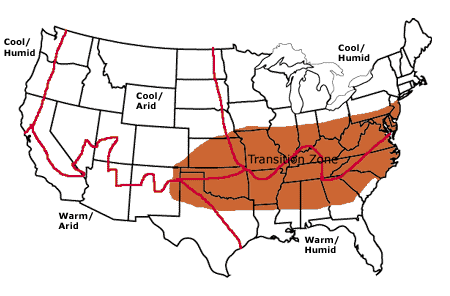 Once you have a general understanding of the differences between warm season and cool season grasses, the next consideration is what climatic zone you live in. The United States can be divided into five primary zones:
Once you have a general understanding of the differences between warm season and cool season grasses, the next consideration is what climatic zone you live in. The United States can be divided into five primary zones:- Cool/Humid: This zone includes Northeast, a few of the Midwest states, and much of the Pacific Northwest. Any of the cool season species can be grown.
- Cool/Arid: This zone includes much of the dryer areas of the Midwest and West. Cool season grass species are best adapted to this area when irrigation is available; however, Buffalo grass is becoming widely used in the warmer areas, such as Kansas, Nebraska, and Colorado for non-irrigated sites. Zoysia grass is also grown in the western and southern parts of this zone
- Warm/Arid: This zone includes the Southwest states. (Use warm season grass species, same as for warm/humid, see below).
- Warm/Humid: This zone includes the Southeast and Gulf states. Warm season grasses are best adapted to this zone. Bermuda grass is the most common species used, but it can suffer winter damage in the most northern areas. Zoysia grass is widely used in the northern parts of this zone. For the Gulf Coast states, carpetgrass, bahia grass, St. Augustine and Seashore Paspalum are widely used.
- Transition: This zone extends through the central part of the United States and includes parts of each of the other four zones. Because the transition zone has cold winters that can kill warm-season grasses and hot summers that can kill cool-season species, this zone is the most challenging in which to grow turf grass. Many turf experts recommend turf type tall fescue for the transition zone as it is the most drought tolerant of the cool season grasses, and it is tolerant of cold winters as well. Other experts recommend using the most cold tolerant warm season grasses such as Zoysiagrass.
Choosing the Right Cool Season Grass
To make the right choice for your particular lawn, ask yourself the following questions?
- How much sun does the lawn receive?
- What’s the purpose of the lawn?
- How much maintenance are you willing to give?
Sunlight is an important factor, and there are some species that tolerate shade better than others. Consider not only the amount of light that the lawn will receive today, but also in the future as shrubs and trees grow and mature. In many lawns, there is a sun/shade combination with areas of the lawn being in full sun all day long and other areas receiving partial shade throughout the day. For this type of area, a mixture is often needed, which means that two different species are mixed together. A common mix for combination lawns is perennial ryegrass and fine fescues.
The purpose of the lawn is also a consideration when selecting a grass. Do you have children and pets playing on the grass regularly? If so, a grass species that is the most wear tolerant and recovers well is best.
Finally, the amount of maintenance that you are willing to give is a factor that will help decide the grass. High quality lawns require frequent applications of fertilizer, regular mowing, summer irrigation, and often they will require the use of herbicides or insecticides. Turf grass species vary in the amount of maintenance that is required to keep high quality.
Once you have answered the questions, you can then choose the species that is best suited to your environment. Now, let’s look at the individual species and what they can offer.
- Kentucky Bluegrass: This grass species provides a dense turf that competes with weeds well and recovers well. It spreads by underground roots called rhizomes, and this allows it to repair when there has been high traffic or stress. It has a medium to fine texture with a dark green color, and it is the most cold tolerant of all the cool season grasses. The root system is fairly shallow, so Kentucky Bluegrass is not drought tolerant and requires irrigation throughout the summer. It often will go dormant during the hottest part of summer, but when fall arrives and temperatures cool, it recovers quickly.
-
Characteristics of Kentucky Bluegrass:
- Shade: low tolerance
- Durability: high
-
Maintenance: high requirements
- Nitrogen use: moderate to high
- Water use: moderate to high
- Dethatching: medium
- Recommended mowing height: 1 ½ to 3 inches
- Perennial Ryegrass: This grass species is known for its fast germination and establishment. It has a fine texture and dark green color, and it does well in full sun and tolerates a little amount of shade. It is very wear resistant and recovers quickly from traffic. It is called a bunch grass because it does not spread by rhizomes or stolons. Ryegrass is often mixed with other species such as bluegrass or fine fescue to create premier grass turf. Perennial ryegrass also needs irrigation throughout the summer, and it can go dormant during the summer and recover again once fall arrives.
-
Characteristics of perennial rye grass:
- Shade: poor to moderate
- Durability: high
-
Maintenance: high to moderate requirements
- Nitrogen use: moderate to high
- Water use: moderate to high
- Dethatching: low
- Recommended mowing height: 1 ½ to 2 ½ inches
- Fine Fescues: This is a group of fescues known for their fine textures and medium to dark green color. Some species include creeping red fescue, hard fescue, and chewings fescue. This group of grasses is tolerant of shade, and they can spread to help repair worn areas. They are not the most wear resistant, but they do not require a lot of fertilizer or maintenance to keep the turf attractive. Fine fescues are fairly drought tolerant, but they will also go dormant during the heat of summer and lose their color. Fine fescues are often used for erosion control and in naturalized areas.
-
Characteristics of fine fescues:
- Shade: excellent
- Durability: moderate
-
Maintenance: low requirements
- Nitrogen use: low to moderate
- Water use: moderate
- Dethatching: low
- Recommended mowing height: 1 ½ to 2 ½ inches
- Turf-Type Tall Fescues: Another bunch grass is tall turf-type fescue. It recovers slowly from damage, but it is extremely wear resistant. Turf-type tall fescue has a medium texture and a dark green color that performs well in full sun but tolerates partial shade. Turf-type tall fescue is the most heat and drought tolerant of the cool season grasses and it withstands cold winters as well. It has a deep root system that enables it to withstand heat and drought, but like the other cool season grasses, it can go dormant under severe heat stress. Turf-type tall fescue requires less care and maintenance than either bluegrass or ryegrass.
-
Characteristics of tall turf type tall fescue:
- Shade: good
- Durability: high
-
Maintenance: low requirements
- Nitrogen use: moderate to low
- Water use: moderate to low
- Dethatching: low
- Recommended mowing height: 2 to 3 inches
Making the right choice of grass is the most important step. Knowing the differences in the species is a tremendous help in making an informed decision. Ask your neighbors what they are growing. Get advice from local county extension agencies. Climates can vary greatly even within a particular zone, so getting knowledgeable advice is always wise.
Choosing the Right Warm Season Grass
- How much sun does the lawn receive?
- What’s the purpose of the lawn?
- How much maintenance are you willing to give?
- How cold are your winters?
Once the questions are answered, we can look at each warm season species to determine which one is the best fit for our use.
- Zoysia grass: This grass species is very water efficient and likes full sun. It tolerates a small amount of shade. It is wear tolerant and has the capacity to recuperate from wear well. Zoysia grass spreads by stolons and rhizomes, but it is slow to spread. Because of its slow growth habit, it also is considered to require less maintenance, and it requires less applications of nitrogen. This grass species has a fine to medium-leaf texture and can be a very attractive, dense lawn with proper maintenance. Cold tolerance is better than Bermuda grass, and Zoysia is often seen in the transition zone.
-
Characteristics of Zoysiagrass:
- Shade: moderate
- Durability: moderate to high
-
Maintenance: moderate to high requirements
- Nitrogen use: moderate
- Water use: moderate
- Dethatching: moderate to high
- Recommended mowing height: 1 ½ to 2 inches
- Cold tolerance: high
- Bermuda grass: It is the most common warm-season grass grown. It is exceptionally wear tolerant and has very good recuperative abilities making it a popular grass for sports fields. It requires full sun and tolerates little to no shade. It spread aggressively by stolons and rhizomes which can make it difficult to contain and keep out of flower beds. Due to it fast growth rate, it is considered to be a higher maintenance grass, requiring more mowing and regular applications of nitrogen. Bermuda grass is very heat and drought tolerant, but it does not perform well in areas with cold winters where it can suffer from winter damage.
-
Characteristics of Bermuda grass:
- Shade: low
- Durability: high
-
Maintenance: high requirements
- Nitrogen use: moderate
- Water use: low
- Dethatching: moderate
- Recommended mowing height: 1½ to 2 inches
- Cold tolerance: moderate to low
- Carpet grass: Not as common as some of the other species, Carpet grass has its place where it performs well. It is a course-textured grass that is slow-growing and requires moderate maintenance. It is well-suited to wet, sandy, acidic areas where other grasses cannot thrive. It prefers full sun to moderate shade, and spreads slowly by stolons. It is native to the Gulf States and prefers areas with warm winters. Carpet grass is not as drought tolerant as Bermuda grass, and because it produces seed heads, it requires weekly mowing and may be considered less attractive.
-
Characteristics of carpet grass:
- Shade: good
- Durability: moderate
-
Maintenance: high requirements
- Nitrogen use: low
- Water use: high
- Dethatching: high
- Recommended mowing height: 1 ½ to 2 ½ inches
- Cold tolerance: moderate
- Centipede grass: This slow-growing grass is considered to be a low-maintenance grass. It spreads slowly by stolons but is not wear tolerant. It is pale green in color and tolerates heat and sun well. Its shade tolerance is fair. Centipede is not considered to be very winter tolerant, nor is it considered to produce an attractive, high-quality turf. Low-maintenance is the most attractive feature for this species.
-
Characteristics of centipede grass:
- Shade: moderate
- Durability: low
-
Maintenance: low requirements
- Nitrogen use: low
- Water use: low
- Dethatching: moderate
- Recommended mowing height: 1 to 2 inches
- Cold tolerance: moderate
- Buffalo grass: There is no grass species that is more heat and drought tolerant than Buffalo grass. It is native to the Great Plains of North America, and its popularity and use as a lawn grass is growing. Buffalo grass spreads by stolons, but it’s a slow-growing grass and is not aggressive. This turf grass is very low-maintenance, needing little mowing, fertilizing, or irrigation. It is not shade tolerant, and it can have a long winter dormancy. In the summer during periods of prolonged heat and drought, Buffalo grass will go dormant, but once moisture is available, it comes out of dormancy and greens up. Buffalo grass is the most cold-tolerant warm season grass, but the degree of tolerance varies among the cultivars.
-
Characteristics of buffalo grass:
- Shade: low
- Durability: low
-
Maintenance: low requirements
- Nitrogen use: low
- Water use: low
- Dethatching: low
- Recommended mowing height: 2 to 4 inches
- Cold tolerance: high
- St. Augustine grass: If you need a warm-season grass and you have areas of shade or partial shade throughout your landscape, St. Augustine tolerates shade the best. It has a creeping growth habit that produces a very thick turf, but it is not durable enough for high traffic or sports fields. St. Augustine grass requires moderate maintenance with high amounts of nitrogen as well as dethatching. It is not cold tolerant, so it is often grown in coastal regions. St. Augustine is tolerant of salinity.
-
Characteristics of St. Augustine grass:
- Shade: high
- Durability: low
-
Maintenance: moderate to high requirements
- Nitrogen use: high
- Water use: moderate
- Dethatching: moderate
- Recommended mowing height: 1 to 3 inches
- Cold tolerance: low
- Seashore paspalum grass: In areas where the soil or the irrigation water has a high salt content, Seashore paspalum grass is a good choice. This grass spreads fairly aggressively by rhizomes and creates a dense turf. Seashore paspalum requires moderate amounts of fertilizer and water, but it does require frequent mowing to keep a short cut. It prefers full sun and tolerates little shade, and it has a low tolerance to cold. Like St. Augustine, it is often grown in coastal regions.
-
Characteristics of Seashore paspalum grass:
- Shade: moderate
- Durability: moderate to high
-
Maintenance: moderate requirements
- Nitrogen use: moderate
- Water use: moderate
- Dethatching: moderate to high
- Recommended mowing height: ½ to 1 ½ inches
- Cold tolerance: moderate
- Bahia grass: Where soils are sandy and infertile, Bahia grass will perform well. It is known for establishing a dense root system, yet the turf is not as thick as the other warm season grass species. Bahiagrass requires little fertilizer or water, but because it produces seed heads which some people find unsightly, it must be mowed frequently. Bahia grass is good for large areas, acreage, roadsides and lawns where a manicured lawn is not expected. It does best in full sun and has little tolerance for shade or high foot traffic. Bahia has poor tolerance to cold temperatures.
-
Characteristics of bahiagrass:
- Shade: moderate
- Durability: moderate
-
Maintenance: moderate requirements
- Nitrogen use: low
- Water use: low
- Dethatching: moderate to high
- Recommended mowing height: 3 to 4 inches
- Cold tolerance: low
Seeding and Establishing Your Lawn
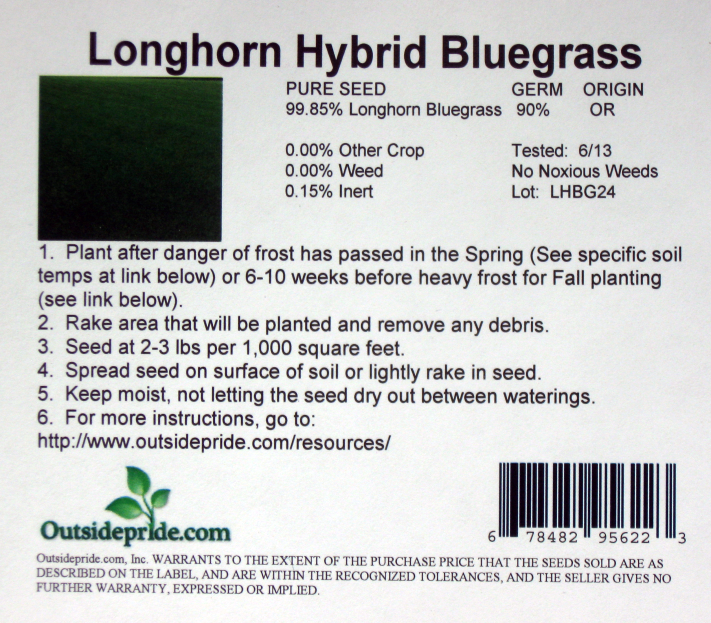 Do you find the various species of grasses fascinating? There are similarities yet slight differences that allow them to be useful to various applications. One attribute that all of these grasses, both warm and cool season, have – with the exception of St. Augustine grass - is that they can all be grown from seeds. Establishing a lawn from grass seeds is far less expensive than using sprigs or sod.
Do you find the various species of grasses fascinating? There are similarities yet slight differences that allow them to be useful to various applications. One attribute that all of these grasses, both warm and cool season, have – with the exception of St. Augustine grass - is that they can all be grown from seeds. Establishing a lawn from grass seeds is far less expensive than using sprigs or sod.You’ve spent the time to select just the right grass species that will grow well in your climate and will meet the requirements that you have in turf grass. Now, you will want to start reading labels. All seed is tested in labs, and the label is a quick analysis of the testing. The label on a bag lists the varieties of grass seed, their germination rate (never buy a seed that has a germination rate lower than 80%), and the amount of crop, weed, and inert matter that is in the seed. Crop, weed, and inert matter should be close to 0.00% except in the case of coated seeds. Many warm season grass seeds are coated, and inert matter can be up to 35%.
To calculate the amount of seed that you will need to purchase, measure the square footage (length x width) of the area to be seeded; once you have the square footage, you’ll need to know the seeding rate for the particular grass seed that you’re planting. The seeding rate is the amount of seed that is used per 1000 square feet of soil. For example, a larger seed such as turf type fescue will be seeded at 10 lbs per 1,000 square feet. A smaller seed such as Kentucky Blue grass may be seeded as low a 2 lbs per 1,000 square feet. Both of these seeding rates will end up giving you approximately 16 seeds per square inch which is the rate at which lawn grasses should be planted.
New Lawns
You have the grass seed, now when and how do you plant?- Seasonal Timing: When starting a turf from seed, the best time to plant is when the temperatures are favorable for rapid seed germination and grass growth. For cool season grasses, the soil temperature needs to be 55° or warmer, and for warm season grasses, the soil temperature must be 65° and warmer. Depending on the grass species, 6 to 12 weeks of good growing weather is needed to get the best establishment of the turf. Cool season grass seed does well with mid-spring or early fall plantings. Warm season grasses take longer to establish, so spring plantings are preferable. The times to avoid are summer when it is difficult to keep new plantings wet enough to ensure uniform germination and late fall when unseasonably cold weather could hit early causing a slow in germination. Thin grass is often the result of late fall plantings, and the weeds find their way in by late winter.
- Rototilling: For newly constructed homes where there the soil is bare and compacted, rototilling serves to loosen the soil to a depth of 6 – 8 inches, and it breaks up the soil into smaller pieces so that it can be graded. Till the soil when it is relatively dry, go over the area 1 – 2 times and avoid pulverizing it into a powder. Having the soil tested is helpful so that you’ll know what the soil may be lacking. This is the ideal time to amend the soil by adding some thoroughly composted organic matter as well as adding lime (if the pH is low). After applying the amendments, till the area again to get a good mix.
- Grading: The combination of raking and rolling using rakes and water-filled rollers is called grading. Rollers and grading rakes can be rented. Using the rake, start with a quick grading to fill in the low spots and knock off the high spots. Then start rolling by going in a back and forth pattern in one direction. Watch areas around sidewalks and driveways. Usually, it’s a good idea to grade these flush with the concrete because the soil will settle slightly when irrigated. The goal is to grade the site smooth with uniform compaction so that no further settling occurs during establishment.
- Wait: Tilling the soil brings up the weed seeds that are naturally in the soil. After the grading, irrigate the soil several times to encourage the weeds to germinate. Once the weeds are up, spray with an herbicide or hand pull the weeds. It’s good to wait 2 – 3 weeks after an herbicide application is made to make sure that all the weeds are dead. Remove the dead weed debris.
- Seeding: The basic goal is to spread the seed over the area so that the grass will germinate uniformly. The best tools for the job is either a broadcast or drop spreader. It’s difficult to know the exact calibration to set the spreader on. Many people simply recommend dividing the seed into two equal quantities. Set the spreader on a low setting and spread the 1st half of the seed going north to south, overlapping the wheel marks so that no area gets skipped. With the 2nd half of the seed spread it going east to west. It’s a good idea to make an extra pass or two where the lawn meets the sidewalks.
- Fertilizing: A starter fertilizer may be applied before or after seeding. Initial emergence is not greatly affected by fertilizer but growth after emergence is stimulated by fertilizer and the establishment of the turf is sped up. It is important to not apply more than the recommended amount as to much can kill grass seedlings. Using a liquid fertilizer like LazyMan™ Soil Doctor is a safe fertilizer to use with seeds. Apply it again 4 – 6 weeks after planting to further accelerate the establishment of the turf.
- Mulching: Mulching is used to help keep moisture near the seed during germination. It is particularly helpful on areas that are exposed to wind or are prone to drying out quickly. The key to mulching is to apply it lightly. No more than ¼ inch is needed. If too much mulch is applied, the seed may not be able to emerge through the layer. Mulch rollers are available to rent. They spread peat moss very easily. Studies have shown that seed that is applied to a well-prepared seedbed and lightly raked in to ensure good contact with the soil does just as well as seed covered with mulch. Again, the raking of the seed into the soil needs to be lightly, ¼ inch or less. Mulching is another cost factor and labor step. The critical aspect is irrigation, and if keeping the seed moist is going to be challenging, applying mulch is much like some added insurance that the seed will not dry out.
- Irrigation: The objective when irrigating the newly seeded lawn is to keep the seed wet. The seed then imbibes water and the germination process begins. The best way to irrigate is several times throughout the day for as long as it takes the surface of the soil to glisten. If puddles form and stay for more than a few minutes, you are watering too much. Normally, you cannot depend on rain, so be prepared to babysit. Once shoots are visible, you can begin to gradually cut the irrigations down.
- Mowing: The lawn is up, and now it’s time for its first trim. Don’t take more than 1/3 of the blade at a time. To avoid creating ruts in the ground, stop irrigating a day or two before mowing so that the soil surface can be firmed up. Also, a sharp blade is important with tender grass that can easily be pulled out by a dull blade. Start a new lawn with a sharp blade!
- Aftercare: Even with killing the weeds before seeding, there may be some additional weeds that have sprouted. After you have mowed 3 or 4 times, you may want to apply a selective herbicide that targets the broadleaf weeds. If herbicides are not your preference, the weeds usually pull very easily and you can get a handle on them before they go to seed. New lawns are hungry, so do not be surprised if the new turf does not hold its color. Be prepared to apply fertilizer every 4 – 6 weeks during that first growing season. A complete, liquid fertilizer is a great way to go that first year in particular.
Renovating an Existing Lawn
If we don’t like the appearance of our lawn, do we have to start at the beginning as though we were going to establish a new lawn? No. There’s a more simplified process that’s great for sprucing up old, tired lawns, and it’s called renovation. Renovating simply means that improvements can be made to an already existing lawn. Renovation can greatly improve the appearance and performance of a turf with much less cost involved as well as time and energy.When is renovation a good option?
- When the lawn has been neglected
- When it is weed-infested
- When part of the lawn has worn out due to heavy foot traffic or animals
- When part of the lawn is dead due to leaves or debris not being raked up and removed
- When there are patches of invading grasses moving in
Maintenance and Care for Lawns
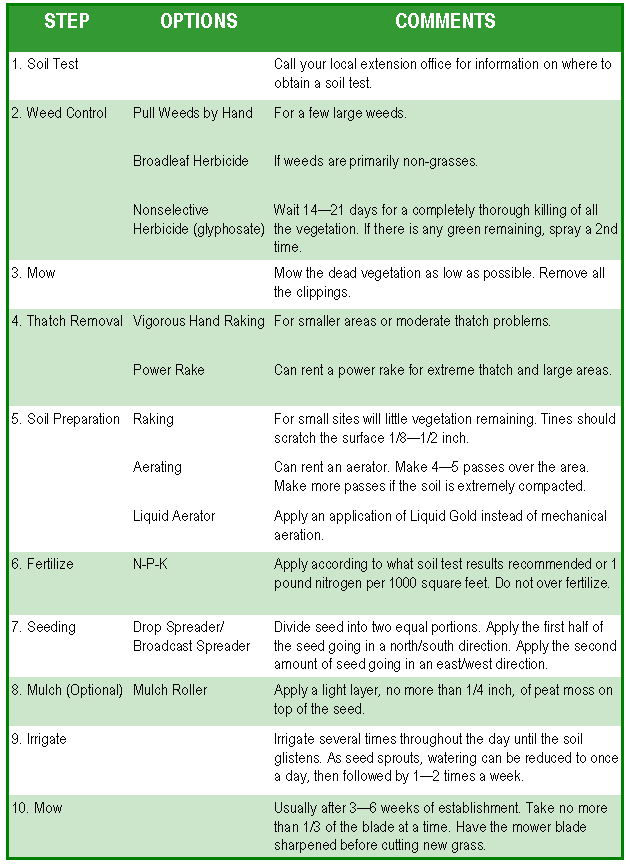
Over 25 years ago, when I was a new home owner, all I knew about the lawn that came with my new house is that it would need mowing. That’s it! I knew virtually nothing about lawn maintenance, and over the years I’ve learned – often by making mistakes – how to better care for my lawn. If you’re like me, and you’re starting out in a new place with little lawn maintenance know-how, here’s a brief description of general lawn maintenance practices.
-
Mowing: If you only choose one turf maintenance task, choose mowing. It might seem like a no-brainer, but there are some recommendations for mowing:
- Mow frequently. Often we only have time on the weekends to get the job done, but our lawns actually will perform better and be more thick and lush when they are mowed often. During the period of greatest growth, the spring, it’s good to remember the 1/3 rule. That simply means to know the recommended mowing height of the type of turf that you have, and only take 1/3 of the blade with each cut. For my lawn, perennial rye, we keep the lawn 2 inches in height, so when the lawn reaches 3 inches, it’s time to mow. For April, our lawn has needed to be mowed about every 5th day, and next month with warming temperatures, it might be every 3rd day. The nice thing about mowing more often: it’s easier and faster to mow!
- Mulch. If you practice the 1/3 rule, mulching, or returning the clippings to the turf, is a wonderful practice that feeds the lawn. Clippings are nothing more than organic fertilizer. Many mowers are equipped with a mulcher to cut the pieces finer, and this is recommended as the small pieces breakdown by soil microorganisms much more easily. Too large of pieces or putting too much down at a time can create a thatch problem, so it’s a practice to use in moderation, but it is a great and natural way to supply some of the fertilizer that the turf needs.
- Lastly, have your mower serviced each winter so that it’s ready to go when spring arrives and mowing is in high demand. A sharpened blade and a balanced blade is a great way to improve lawn quality and health.
-
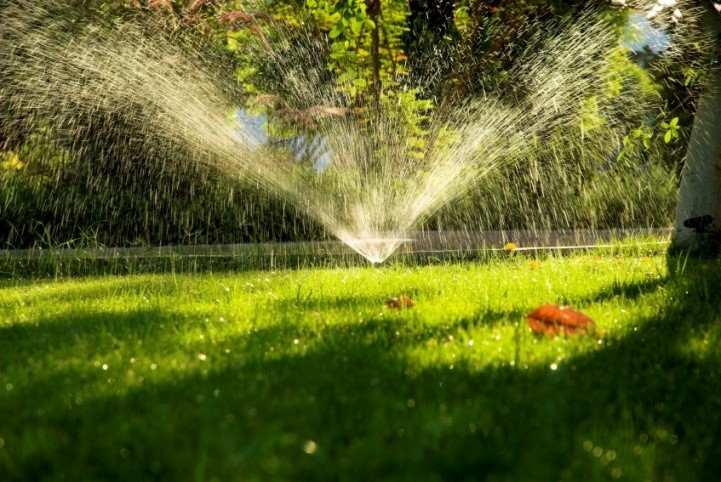 Watering: Turf grass needs water to survive, and when the color is still dark green but it doesn’t spring back when stepped on, it needs some water. Here are some watering recommendations:
Watering: Turf grass needs water to survive, and when the color is still dark green but it doesn’t spring back when stepped on, it needs some water. Here are some watering recommendations:
- Instead of following a particular watering schedule, observe your turf and determine when it needs water. Insert a 6-inch screwdriver into the lawn. If it penetrates easily, hold off on watering, but if it takes effort to push it into the soil, it’s time to water.
- Apply only the amount of water that’s needed. For the hottest months usually 1 – 1½ inches per week of water is needed. Calculate the amount of water that your sprinkler or irrigation system applies by placing shallow containers (like a tuna fish can) throughout the area being watered. Run the sprinklers for 20 minutes, measure the depth of water in the cans and calculate the average depth. With this information you will know how long the water needs to run.
- Know your soil type. Ideally, irrigation will be done once each week, but if your soil is on the clay side, run-off can occur, so irrigating in twice a week allows the water to soak in. If the soil is sandy loam, there would be less run-off and less applications needed.
- If you don’t mind a dormant, brown lawn, that’s perfectly fine. Depending on where you live, you may have regular rains that come through in the summer that might be an adequate amount of water to sustain the lawn. For extended dry periods, however, an occasional deep irrigation will ensure that the grass root stay alive.
-
Dethatching: Thatch is a tightly interwoven layer of dead and living stems, roots and leaves that builds up between the soil and the actively growing grass. It is absolutely normal in actively growing grass, and when the layer is not too thick, the thatch actually improves the resilience of the turf to traffic.
- When does thatch become a problem? An excessive amount of thatch, which is usually considered more than an inch, can restrict the movement of water, air, and nutrients to the grass roots. Often the grass begins to root in the thatch itself because it needs the water and nutrients that are restricted in the thatch and not moving into the soil. The result is a grass that is not resistant to heat and drought. The thatch layer also can harbor fungi that can cause lawn diseases. Once the temperature and moisture conditions are right, the disease can spread through the entire lawn quickly. An excessive amount of thatch actually weakens turf grass and makes it far more susceptible to pests and diseases.
-
Why does thatch develop? The soil is filled with microorganisms that breakdown the dead plant material. Healthy soil that is filled with a population of earthworms and microorganisms that will naturally breakdown dead debris and help keep the thatch layer from becoming too excessive. Studies have found that soil compaction and acidity plays an important role in the decreased population of microorganisms, so aeration of soil and keeping the pH level at 6.5 is beneficial in keeping the microorganism numbers flourishing. There are also some lawn maintenance practices that can create more thatch such as:
- Applying unbalanced fertilizers or too much nitrogen can promote disease development.
- Indiscriminate use of fungicides and pesticides can reduce the healthy populations of earthworms and microorganisms.
- Do all grass species develop thatch? The answer is yes, but many grass species are more likely to develop a thatch layer more quickly. Grasses that have rhizomes and/or stolons (side shoots that help the grass spread) develop thatch more readily. Blue grasses, bent grasses, Zoysia grasses, and Bermuda grasses are all species that can build thatch quickly.
- How do you remove thatch? If there is excessive thatch, there are machines that can be rented such as vertical mowers, power rakes, verticutters, or dethatchers that slice through the thatch and pull some of the debris out. All of the thatch material should not be removed in one treatment. Many experts recommend a late summer or early fall dethatching if using a machine. There are also natural products that can be applied to the lawn that contain microbes that eat the dead debris. Liquid Gold is such a product that accelerates the natural thatch decomposition so that with time mechanical dethatchers are not needed. Dethatching should only take place when there is an excessive layer build up.
- Does mulching and leaving the grass clippings build thatch? It seems like it would cause a problem, but the answer is actually no. Leaving short, mulched clippings does not build more thatch. A great amount of research has been done on this particular lawn maintenance practice, and mulched clippings break down quickly and add nutrients into the soil.
-
Fertilizing: Fertilizer is nothing more than food for the turf, and it helps to maintain its health so that it is not susceptible to diseases and easily taken over by weeds and invading grasses. Applying the right amount of fertilizer at the right time is important. Some recommendations to consider:
-
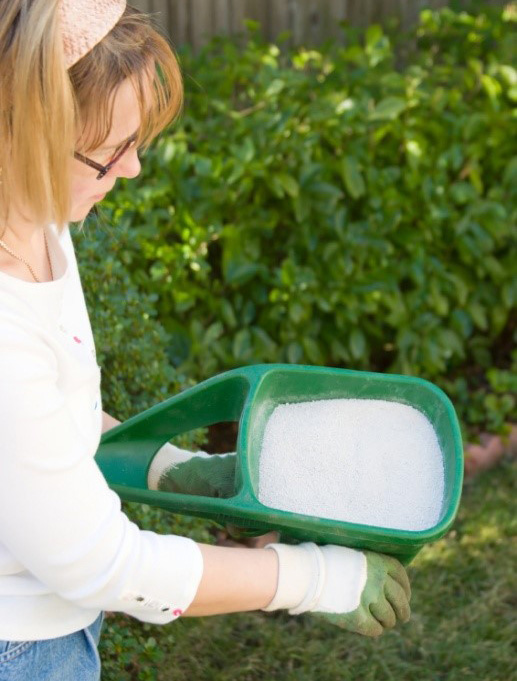 Fertilizer should be applied when the grass is actively growing, so the fertilizing schedule is going to be determined by what type of grass you have and the time of year it is. Cool season grasses grown in the northern climates (ryegrass, blue grass, fine fescue) should be fertilized in the spring and again in the fall. Warm season grasses that are grown in hot climates (bermuda, zoysia, carpet) should be fertilized in the spring and summer. Two applications of fertilizer are the minimum recommendation to maintain health.
Fertilizer should be applied when the grass is actively growing, so the fertilizing schedule is going to be determined by what type of grass you have and the time of year it is. Cool season grasses grown in the northern climates (ryegrass, blue grass, fine fescue) should be fertilized in the spring and again in the fall. Warm season grasses that are grown in hot climates (bermuda, zoysia, carpet) should be fertilized in the spring and summer. Two applications of fertilizer are the minimum recommendation to maintain health. - Nitrogen is the one nutrient that is nearly always lacking in the soil, and depending on soil test results, phosphorous and potassium may be needed as well. Knowing both the soil conditions and the needs for the particular type of grass you’re maintaining will help to determine which fertilizer product you purchase. A typical application to maintain a healthy turf is to apply 1 pound of nitrogen per 1000 square feet of turf.
-
Read the label carefully. If the label says 20-4-16, 20% of the product is nitrogen, 4% is phosphorous, and 16% is potassium. So, how do you know when you’re applying 1 pound of nitrogen per 1000 square feet? Here’s a handy reference chart based on the percentage of nitrogen in the fertilizer:
Nitrogen in fertilizer Amount of product to apply (pounds) per 1000 square feet 10% 10 15% 7 20% 5 25% 4 30% 3.5 35% 3 40% 2.5 - When in doubt about fertilizer needs, the local extension office in your area is a great source of information. Some extension offices even do soil tests and have free fertilizing publications to help you determine what your specific turf needs.
-
-
Aerating: Simply said, aeration is supplying air to the soil. Holes are made throughout the soil, and these holes or channels allow oxygen and water to move into the soil.
- Why is aeration needed? Over time, soil can become compacted especially in high traffic areas. As the soil becomes compacted, the grass roots are not able to receive nutrition, oxygen and water, and the root growth is restricted. When the grass roots are not thriving, the grass will be less resistant to temperature extremes, drought, and it will be more susceptible to disease. Often the grass will thin out and become sparse in highly compacted areas.
- How is aeration done? There are several methods of aerating. The hollow tine aerator actually pulls out a core of soil. These power machines are typically rented or landscapers will come in and perform the service. The cores are about 3 inches long and are left on the surface of the lawn to breakdown over a period of a week or more. There are also solid tine aerators that are 3 - 4 inch spikes to penetrate the soil. Spike aerators come in a variety of forms from large drums with spikes that you roll over the lawn, to sandals that are worn while you walk. Lastly, there are liquid aerators that have the ability to loosen soil structure and increase the permeability of the soil. Products like LazyMan Soil Doctor™ can be sprayed on or applied through a garden hose applicator.
- When should you aerate? Aeration can be done anytime that the ground is not frozen. However, for cool season grasses, the most recommended time for aeration is in the spring when the soil is moist and the grass is actively growing. Aerating in the spring creates a better root mass and helps to ensure that the grass will survive the heat and drought of summer. Warm season grasses can be aerated in mid-spring to early summer. They should be completely out of dormancy and actively growing when the aeration occurs. Avoid aerating when the ground is dry or when it is overly wet and soggy.
-
What are the advantages of aerating the lawn?
- It increases soil oxygen and water penetration
- It encourages root growth
- It reduces soil compaction
- It increases germination of over-seeded grasses
- It increases the movement of nutrients into the soil
- It helps to reduce thatch
- Weed Control: By practicing the previous 5 basics, weeds will be kept to a minimum. If weeds do become an issue and you choose to apply an herbicide, spring and fall are the most effective times for elimination. The turf and weeds should be vigorously growing and the temperatures should be not more than 80F°.
-
There is some common terminology when using lawn herbicides. Here are a few to be familiar with:
- Selective herbicide – they eradicate only targeted plants. A selective herbicide for lawn use would be one that targeted broadleaf weeds (dandelion, clover) and did not damage the turf.
- Nonselective herbicide – they eradicate all plants including grasses.
- Pre-emergent herbicide – they are “weed preventers” that are put down in early spring to prevent weed seed from germinating. It’s common to see pre-emergents for crabgrass.
- Post-emergent herbicide – they are for eradicating an established weed, and they do nothing to prevent seed.
-
Lawn Disease Control: Thankfully, diseases of the lawn are the exception and not the rule, but it’s good to have a basic understanding of how disease can possibly develop and affect the turf grass. Lawns can have spots or patches that are discolored, but that does not necessarily mean there is a disease. Injuries can occur to the lawn such as drought, mowing the grass too short, or damage from excessive herbicide. Those injuries can look like disease, but there are no pathogens (disease causing organisms) involved. But, an injured turf may be weakened so that it becomes susceptible to pathogens.
-
There are 3 factors that must exist in order for a disease to develop:
- A susceptible plant
- A disease producing organism or pathogen
- An environment favorable to the growth of the disease
-
Most every lawn has some susceptible grasses and dormant pathogens (usually fungi).
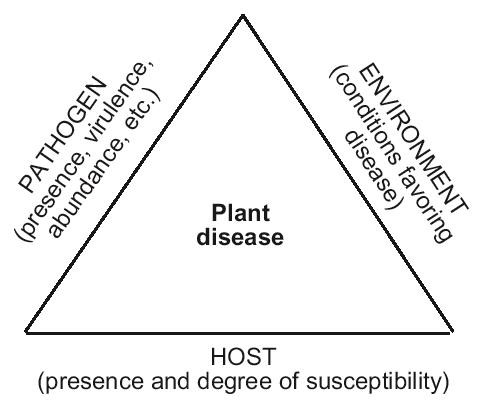 Diseases do not begin to develop until the environmental conditions begin to favor the population of pathogens or increase the susceptibility of grasses. Environmental conditions can include the weather such as temperatures and drought or excessive moisture as well as changes in maintenance.
Diseases do not begin to develop until the environmental conditions begin to favor the population of pathogens or increase the susceptibility of grasses. Environmental conditions can include the weather such as temperatures and drought or excessive moisture as well as changes in maintenance. - There are potential turf grass diseases for nearly every environmental condition. There are diseases that occur in the cold of winter under snow, and there are other diseases that occur during the heat and humidity of summer. Wet soils and high rates of fertilizer can trigger diseases just as dry soils and poor fertility can bring on disease.
-
So, the emphasis for you, the average home owner, needs to be on the care of grass to prevent disease. Controlling the weather or overall environment is impossible, but there are practices you can keep that will change the local environment and that do not promote disease development.
- Mowing – cutting grass below optimum height causes the grass to be stressed; mower blades need to be sharp so that they cut the grass instead of tearing it; mow frequently enough so that no more than 1/3 of the leaf is cut at one time; avoid mowing wet grass.
- Watering – time irrigation to the early morning hours; irrigate only when drought stress is observed and then apply enough water to saturate the root zone; irrigating every day for a short duration does not provide ample water to the root zone, but it is beneficial to the turf grass pathogens.
- Nutrition – many diseases are directly affected by the nutrition of the grass, especially nitrogen; both excessive nitrogen and low nitrogen contribute to disease, so it is best to apply the minimal amount of nitrogen that is required by the turf grass; potassium is important in the prevention of disease; damaged grass benefits for the application of liquid fertilizers that can be absorbed both through the leaf tissues and the roots.
- Thatch – a thatch build up of more than 1 inch can lead to increased stress and disease; remove excess thatch.
- Soil – aerate soil to improve the ability for air, water and nutrients to be able to flow into the root zone; monitor the pH of the soil.
-
There are 3 factors that must exist in order for a disease to develop:
- What do you do when despite your best efforts a disease occurs? There is nothing easy when it comes to lawn diseases. Assistance from university extension agencies and lawn care professionals is very helpful. Turf grass professionals are able to identify the disease, identify the environmental factors that have promoted the disease, and they are able to recommend management practices that will decrease the stress on the grass and make it less susceptible.
- Lawn care professionals may treat the disease with a fungicide. Fungicides are pesticides that kill fungi, and they can be a part of the disease-control program, but first the disease must be identified before fungicides are used. Even though fungicides are available in many retail stores, without direction from extension agencies or professionals, the use is discouraged as it requires knowing which fungicide to use and the correct timing of the application(s).
Sustainable Lawns
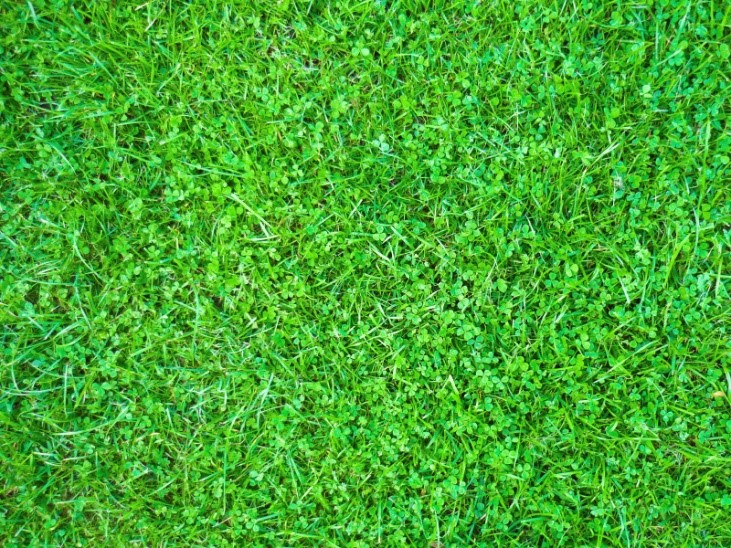 White clover is a perennial legume that fixates nitrogen from the air and makes it available in the soil. It grows all over North America, in sun or shade, fertile or non-fertile soils, and it often shows up uninvited in our lawns. Before the creation of selective herbicides that are be sprayed on grass lawns and kill only the broad leaf weeds, clover was commonly found in all lawns. But, it’s rounded leaves can stand out in a lawn and create an uneven appearance and texture. That’s when it does look rather weedy and is often killed out. But what if the clover was evenly dispersed throughout the lawn and it was allowed to grow right along with the grass? It actually doesn’t look bad, and there are so many benefits to allowing clover to grow:
White clover is a perennial legume that fixates nitrogen from the air and makes it available in the soil. It grows all over North America, in sun or shade, fertile or non-fertile soils, and it often shows up uninvited in our lawns. Before the creation of selective herbicides that are be sprayed on grass lawns and kill only the broad leaf weeds, clover was commonly found in all lawns. But, it’s rounded leaves can stand out in a lawn and create an uneven appearance and texture. That’s when it does look rather weedy and is often killed out. But what if the clover was evenly dispersed throughout the lawn and it was allowed to grow right along with the grass? It actually doesn’t look bad, and there are so many benefits to allowing clover to grow:- It fixates nitrogen and provides the essential nutrient to the grass throughout the entire growing season. Because of the continual release of nitrogen, the grass is healthier and able to tolerate heat, drought, and diseases.
- It helps aerate the soil and reduce compaction. The clover roots go deeper than the grass roots, and break up the soil and reduce compaction.
- It spreads by stolons and weaves its way through the grass creating a more wear tolerant turf. Also, because the turf is thick, many encroaching weeds are kept out of the lawn.
- It keeps its dark green color longer in heat and in winter.
- It is tolerant of sun and shade.
There are now improved species of perennial white clover that have much smaller leaves allowing them to blend into the turf better. Miniclover grows the same, provides the nitrogen the same as the larger species, but with the smaller leaves, the texture blends and creates a visually attractive lawn as well as a sustainable lawn.
When seeding a new lawn, seed with 2 – 5% clover seeds. Clover seeds are small, and can be mixed in with the grass seeds for an even dispersal. Lawns that are already established can be over-seeded with clover seeds in the spring or the fall.
A grass clover mixture might not be suited for every landscape, but if you live in a rural setting or in an area that does not have strict rules governing the neighborhood landscapes, these grass clover lawns really are sustainable and economical.
Organic Lawn Care
Organic Lawn Care
The emphasis in organic lawn care is on the continual improvement of the soil which in turn produces healthier grass. Healthy grass is able to withstand heat and drought, maintain density to keep weeds from encroaching, and resist disease and pests. However, soil improvement takes time, and often there are not the fast, visible results as there are with synthetic products. A different mindset goes along with organic lawn care. There has to be patience as well as a certain amount of tolerance. The picture-perfect lawn that can be obtained using the conventional lawn products may not be the end result of using natural, organic methods. “When natural organic methods are used consistently over time, a reasonably uniform green lawn that is resistant to adverse environmental conditions and/or pests can be expected.” Ohio State University Extension Fact Sheet (see resources).
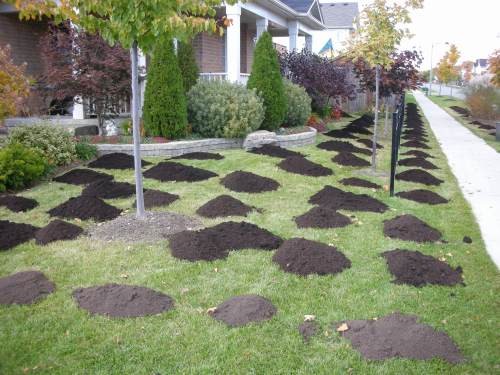 There has been a considerable amount of university-based research on the improved performance of turf with the use of top dressings of compost. Today, the practice of top dressing is used by many who prefer a more organic approach to lawn maintenance as well professional turf managers of sports fields and golf courses.
There has been a considerable amount of university-based research on the improved performance of turf with the use of top dressings of compost. Today, the practice of top dressing is used by many who prefer a more organic approach to lawn maintenance as well professional turf managers of sports fields and golf courses.What is a top dressing? Simply put, it is a thin layer of material, ¼ to ½ inch, which is spread over the top of the turf. The materials used for top dressing can include sand, soil, composts or a mixture of any of these. The best times of year to top dress are in the fall before frosts are expected or in the spring after the first mowing. Adding a top dressing is a way to slowly add organic amendments to the soil and improve it without disturbing the growth of the grass. The improvements in the soil might not be immediately visible, but following a routine over a period of several years, the following list of benefits is attributed to top dressings of compost:
- Provide nutrients
- Increase organic matter
- Improve soil structure
- Reduce irrigation
- Reduce thatch
- Improve surface irregularities
- Add beneficial microbes
- Reduce winter damage
- Reduce weeds
- Reduce nutrient loss to surface and ground water
Composted material is easily added to gardens or beds where the large clumps are usually left to further breakdown. But with grass, it’s helpful to sieve the compost so that the large clumps are removed and put back into the compost bin. A homemade screen can be made from 2 x 4s and made to fit over a wheel barrow. Use a piece of hardware cloth that has ½ inch openings, and secure the piece to the wooden frame. The organic material to be placed on the lawn should be dry and easily pass through the screen. Once you have the material screened, you can spread it by using a large drop spreader, by dumping small piles and then raking it out, or by simply using a shovel and flinging the material over the lawn. Typically only ¼ to ½ inch of top dressing is applied. At least half of the leaf height should be visible or the grass may be killed by a lack of sunlight. Except for areas in the turf grass that are already thin with soil exposed, a top dressing should not be visible.
Top dressings can be used to even out bumps and swales. In this case the top dressing may be a mix of soil and composted material, and the depth may be deeper. The area can then be over-seeded with grass seed. Lightly rake the seed into the top dressing and keep the area moist for good germination and establishment. Lawn overseeding should be done when the soil temperature is optimal for your specific area.
Core aeration can be done before or after top dressing, and it helps to incorporate the organic material into the soil. Irrigating after the application of top dressing also helps integrate the compost down into the turf.
If you do your own composting, you know exactly what is in the compost and how well-processed it is. Many home owners find themselves looking for compost to purchase. When purchasing compost, it is important to find a reputable supplier who can provide an analysis of the product. How do you know how much to purchase? First, determine the amount of surface area to be covered then multiply the area by the depth of compost desired (in feet).
For a 5000 square foot lawn being covered with ¼ inch of compost, the math would be 5000 feet2 lawn x 0.02 ft compost = 100 feet3. Usually, compost is sold by the cubic yard. Divide 100 feet3 by 27 = 3.7 yards3. So, for a 5000 square foot lawn, 4 cubic yards of compost would cover it at a depth of ¼ inch.
Many homeowners have replaced synthetic fertilizers with a yearly top dressing. It may involve more work, but as composted materials continue to breakdown into the lawn and add nutrients to the soil, the results begin to become obviously visible and rewarding. A healthy lawn is better able to recover from dormancy, tolerate a summer drought, resist a disease outbreak, or repair after heavy wear and tear from foot traffic, and top dressing definitely results in a healthier lawn.
Improve Your Soil the LazyMan™ Way!
If you knew there was a product that would greatly improve your soil, would you give it a try? There is such a product, and it’s called LazyMan Liquid Gold™. Improve the health of your soil with an easy-to-apply liquid that can easily be mixed into your backpack or handheld sprayer, or it can be attached to your garden hose for dispersal.
LazyMan Liquid Gold™ is also a great product to use in the flower beds and vegetable garden and will improve the quality and workability of the soil. Whether you used a hand cultivator to work your
flower
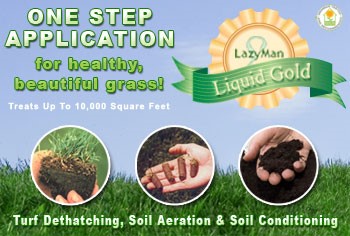 beds or a rototiller to prepare your vegetable garden, LazyMan Liquid Gold™ will make your work easier, and it’s a simple way to keep the soil in your gardens, flower beds and lawns healthy and productive!
beds or a rototiller to prepare your vegetable garden, LazyMan Liquid Gold™ will make your work easier, and it’s a simple way to keep the soil in your gardens, flower beds and lawns healthy and productive!-
What is LazyMan Liquid Gold™? It’s an all natural, powerful liquid that can easily be mixed into your backpack or handheld sprayer, or it can be attached to your garden hose for dispersal. It is easy to use and there are multiple benefits.
- Aeration: It helps reduce crusting, loosens up hard clay soils, aggregates sandy soil, and allows water and oxygen to better reach plant roots by reducing the surface tension between the water and the soil. LazyMan Liquid Gold™ is designed to decrease the surface tension between water and soil while improving the growth and activity of micro-organisms necessary for a healthy soil environment.
- Dethatching: For lawns, thatch is a layer of grass stems, roots, clippings, and debris that settle on the ground and either slowly decompose and/or accumulate over time and cause a decline in the grass health. LazyMan Liquid Gold™ contains an advanced formulation of naturally occurring microbes that feed on dead plant tissue. The microbes accelerate the decomposition of thatch into nutrient rich humus. These microbes are also beneficial when applied to flower beds and gardens as the dead plant tissue is broken down more quickly, adding humus to the soil. Improved amounts of humus then improve the structure of the soil.
- Soil Conditioning: LazyMan Liquid Gold™ adds organic compost to the soil through humic acids and kelp. The organic compost physically improves the soil and increases its water holding capacity which will help resist drought. The conditioners also improve the soil chemically by retaining the natural nutrients in the root zone and releasing the nutrients as plants need them. Lastly, the organic conditioners biologically stimulate plants and even increase germination and viability of seeds.
- Hasresearch been done on the product? Yes, there has been extensive research done on such things as the effects on plant seed, root growth and density, the effect on clay soil, the effect on turf density and so much more. Here is a link to the LazyMan™ research.
- Are there any photos that show the benefits of using LazyMan Liquid Gold™? Yes, there are photos from the research that was done as well as photos that customers have sent in. Here is a link for before and after photos.
- How safe is the product? LazyMan Liquid Gold™ is safe to use and is very environmentally friendly. It is safe to use around animals, pets, and people. However, when using any product, precautions should be taken to avoid direct skin or eye contact due to possible irritation.
- How often do you have to apply LazyMan Liquid Gold™? This depends on the starting point of your soil; however there are general guidelines. LazyMan Liquid Gold™ is a very large molecule product and doesn't break down easily. We recommend one initial application, followed by another application 6 weeks later. Depending on environmental factors, these initial treatments can last up to one year. You CAN NOT over apply the products and could use them every month if you desire to.
- What is the application rate? Dilute 3 to 6 ounces (6 ounces recommended for first application) of LazyMan Liquid Gold™ with 5 gallons water for each 1,000 square feet or 1 to 2 gallons per acre of soil to be treated. The product may be applied with hose-end sprayer (set dial hose-end sprayers to 2 ounces per gallon), backpack sprayer, hand held sprayer, or through irrigation system. If sprayed, a thorough watering should follow application.
-
How much coverage can I expect from a quart? The coverage breakdown is as follows:
- LazyMan Liquid Gold™ 1 quart - Up to 10,000 Square Feet
- LazyMan Liquid Gold™ 1 gallon - Up to 40,000 Square Feet
- LazyMan Liquid Gold™ 2 1/2 Gallons - Up to 100,000 Square Feet
- Are there any dangers with over applying? No. This product is not like fertilizer where over applying can cause severe burning and even kill plants. These products are not "bioaccumulative" and will not build up in plants. They will NOT harm any type of plant or grass.
- When should I apply LazyMan™? You can apply the product during any time of the year as long as the ground isn't frozen. It is recommended applying when day time temperatures are a minimum of 35 degrees. Water the area for 15 minutes after applying the product.
- Can I apply LazyMan™ products before seeding or over-seeding my lawn? Yes. You can apply the product before seeding, during seeding, or after seeding. The only effect you get from LazyMan™ products is positive and beneficial to young seedlings.
- Can I apply LazyMan Liquid Gold™ to my vegetable garden and flower beds? Yes. LazyMan Liquid Gold™ can virtually be used throughout your entire landscape. If the product is used in the early spring before working the soil, the garden will rotor-till more easily, and a shovel or fork goes into raised beds much more easily. Hand cultivators in flower beds will penetrate and loosen the soil more easily, and weeds will pull out with less resistance.
- What is the shelf life of the product? It is recommended that the LazyMan™ products be used within two years after purchase.
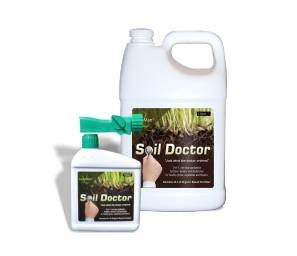 There is a second impressive liquid product that will improve your soil and add nutrients as well. Whether you are growing vegetables, ornamentals, shrubs, ground covers, or lawns, LazyMan Soil Doctor™ will provide the aeration, dethatching, and soil conditioning as well as a fertilizer (10-3-6). The fertilizer is biologically enhanced and will simultaneously address soil health and plant nutrition. This enhanced formulation contains a select grouping of highly beneficial soil microorganisms, kelp extracts and potassium humate. The liquid fertilizer is the ideal choice for turf, ornamental, agricultural and greenhouse applications.
There is a second impressive liquid product that will improve your soil and add nutrients as well. Whether you are growing vegetables, ornamentals, shrubs, ground covers, or lawns, LazyMan Soil Doctor™ will provide the aeration, dethatching, and soil conditioning as well as a fertilizer (10-3-6). The fertilizer is biologically enhanced and will simultaneously address soil health and plant nutrition. This enhanced formulation contains a select grouping of highly beneficial soil microorganisms, kelp extracts and potassium humate. The liquid fertilizer is the ideal choice for turf, ornamental, agricultural and greenhouse applications.You can feel good about using LazyMan Soil Doctor™ anywhere in your landscape! It is not just a temporary fix for soil, but instead, it is working to keep the soil productive and healthy. Start with a spring application of this product to feed your soil, and soon you will have flowers blooming, a crop of fruits and vegetables, and a thick, lush lawn for your family to play on and enjoy.
What an amazing journey this e-book has taken you on! The journey started with selecting the right grass for your climate, to seeding and establishing the lawn, and it ended, finally, with maintenance practices to keep the turf healthy and thriving. There are lawn care professionals who are happy to have you hire them for their services, but growing and caring for a beautiful lawn can be a personally rewarding and satisfying experience.
Having the lawn of your dreams is very purposeful. It may require diligence and hard work, but what a satisfaction and reward to be able to use and enjoy a lush, beautiful stand of grass. Going barefoot in the grass is not just for the kids. Go ahead. You know you want to … take off your shoes and enjoy!
Resources Used
Introduction:http://ag.udel.edu/udbg/sl/vegetation/Turf_Grass_Madness.pdf
http://www.history.vt.edu/Barrow/Hist3144/readings/pollan.html
http://www.sustland.umn.edu/maint/benefits_5.html
Cool Season or Warm Season Grasses:
http://www.fsl.orst.edu/forages/projects/regrowth/main.cfm?PageID=33
http://www.commodities.caes.uga.edu/turfgrass/georgiaturf/Turfgras/index.html
http://www.usna.usda.gov/Gardens/faqs/turfgrassfaq2.html
http://www.ipm.ucdavis.edu/TOOLS/TURF/ESTABLISH/seasongrth.html
Cool Season Choices:
http://www.clemson.edu/extension/hgic/plants/landscape/lawns/hgic1214.html
http://urbanext.illinois.edu/lawnchallenge/lesson1.html
http://www.ipm.iastate.edu/ipm/hortnews/2004/8-13-2004/turfgrasses.html
Warm Season Choices:
http://www.ipm.ucdavis.edu/TOOLS/TURF/ESTABLISH/seasongrth.html
http://www.turffiles.ncsu.edu/turfgrasses/Carpetgrass.aspx
http://aggie-horticulture.tamu.edu/archives/parsons/turf/publications/carpetgrass.html
http://www.uaex.edu/Other_Areas/publications/PDF/FSA-2112.pdf
http://aggie-horticulture.tamu.edu/archives/parsons/turf/publications/carpetgrass.html
http://edis.ifas.ufl.edu/lh006
http://www.turffiles.ncsu.edu/pdffiles/004175/ag69.pdf
http://extension.missouri.edu/p/G6730
Seeding and Establishing Your Lawn:
http://www.ext.colostate.edu/ptlk/1516.html
http://www.extension.iastate.edu/publications/pm1072.pdf
http://extension.oregonstate.edu/catalog/pdf/ec/ec1550.pdf
Maintenance and Care for Lawns:
http://www.uri.edu/ce/factsheets/sheets/organiclawncare.html
http://ohioline.osu.edu/hyg-fact/4000/4031.html
http://www.life.illinois.edu/pollinatarium/Bulletin_board/Lawn_care/
http://www4.ncsu.edu/~djgofort/lawn3.htm
http://buckeyeturf.osu.edu/index.php?option=com_content&view=article&id=960:white-clover-in-turf&catid=1:latest-news&Itemid=170
http://extension.umass.edu/turf/fact-sheets/white-clover-lawns
http://clark.wsu.edu/volunteer/mg/gm_tips/TopDressing.html
http://learningstore.uwex.edu/assets/pdfs/A3710.pdf
http://urbanext.illinois.edu/gardenerscorner/issue_08/spring_03_12.cfm
http://my.extension.uiuc.edu/documents/915090609090909/Topdressing_turf_with_compostrev.pdf
http://www.coopext.colostate.edu/TRA/PLANTS/core.html
Photo from: http://www.compostjunkie.com
Aeration & Dethatching:
http://www.ext.colostate.edu/ptlk/1505.html
http://learningstore.uwex.edu/assets/pdfs/A3710.pdf
http://ipm.missouri.edu/MEG/2012/3/Spring-Lawn-Care-Aeration-Fertility-and-Crabgrass-Control/
http://pubs.ext.vt.edu/430/430-533/430-533.html
http://www.uri.edu/ce/factsheets/sheets/thatch.html
Disease:
http://www.ipm.ucdavis.edu/PMG/PESTNOTES/pn7497.html
http://turfdiseaseid.ncsu.edu/Default.aspx
http://plantscience.psu.edu/research/centers/turf/extension/factsheets/managing-diseases
http://edis.ifas.ufl.edu/lh040
http://www.ca.uky.edu/agc/pubs/id/id105/id105.htm
































